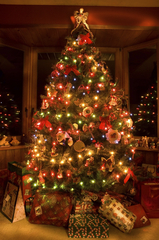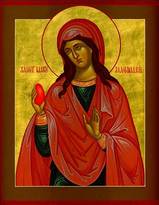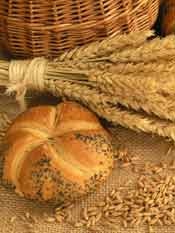A Pagan heritage is most obvious in the
feasts and celebrations we both share. The eight Sabbats are closely
linked both in date and intent to the feasts of the Christian calendar.
This makes merging the two faiths
extremely easy for someone who wishes to practice Christian Craft. Practicing Christian Craft does not mean you have to merge all celebrations; you can
choose to focus on the Pagan aspects or on the Christian ones, or you can
choose to celebrate both!
Let’s take a look at each one and
discover the Christian Earth Spirituality Wheel of the Year. You’ll find here each Sabbat listed with its Christian
equivalent, along with the common themes they share. I’ve also included a
ritual practice or tradition that can be used to build a celebration that truly
honors both the Christian and Pagan aspect of the feast day.
Blending your Wheel , if you like is simple. There is anti Christian or anti-Pagan , there is simply celebrating the beauty the earth and your divine has to offer in way meaningful to you. Most the sabbats and holidays are linked anyhow, sharing common themes, and origins in ancient cultures. A honest study of traditions, religions, and cultures will lead to this conclusion.
Blend what you like, take-away what resonated with your, and leave the rest. Celebrate your personal connections and family. You spirituality is a personal experience, and do not let anyone tell you otherwise.
For me, I love the idea of celebrating with family , friends, and community all there is to celebrate, Pagan, Christian , and secular. Find your own meanings in both the old and new ways, and create you own unique path that serves you and your divine.
All Souls
Hallow Eve
Samhain

Samhain: October 31
All Saints and All Souls Days:
November 1st and 2nd, respectively
The Christian celebration dates to the fourth century. It commemorates the lives of the saints and the people who have passed on. It was moved to November 1st by Pope Gregory III to coincide with Pagan celebrations.
Common theme: Remembrance of our ancestors
Ritual practice: The dumb supper is one way to acknowledge the presence of our ancestors on the night on this night. It is believed that on this night, the veil between the realm of the living and of the dead is extremely thin and that our ancestors can come back to visit. The dumb supper consists of setting an extra place at the dinner table to welcome them back and to share in their company as we used to when they were living amongst us. It is a great family ritual that teaches that death is a passage and that the ones who have passed on are never really forgotten.
Dia de los Muertos is a Mexican celebration in remembrance of ancestors signified by skeletons and marigold.
Christmas
Yule

Yule: December 21
Christmas: December 25
Yule is celebrated on the winter solstice, the longest night of the year.
The date for Christmas was chosen by the roman Emperor Aurelian in the third century, to coincide with the feast of the Unconquered Sun. So, for both these feasts, we see a strong association with the power of the sun. and the birth of the Son of God, the Light of world.
Many pagan traditions were incorporated in the Christmas feast. Boniface introduced the Christmas tree, which was a Germanic tradition. Also,
Santa Claus is an amalgamation of St. Nikolas and the god Odin.
Common theme: Encouraging light in times of darkness. This light is represented in various ways: the unconquered sun, the star of Bethlehem, Jesus as the light of the world, or simply by the ritual use of candles.
Ritual practice: Burning candles throughout the night is a practice of both Pagans and Christians.
Christians perform a midnight mass on this night, a symbol of keeping the light burning in the darkest of the night. Pagans let candles burn all night long to give strength to the sun on the longest night of the year.
Imbolc
Candlemas

Imbolc: February 2nd
Candlemas: February 2nd
Imbolc celebrates the efforts of the God to woo the Goddess out of her wintry sleep.
For Christians, this date also honors the sacred feminine in the person of the Virgin Mary. It is called Candlemas because it is customary to burn candles in a procession on this date.
Common theme: Devotion to the Goddess
Ritual practice: Imbolc or Candlemas is a great day to honor the Sacred Feminine. It can be done in a traditional way, like burning candles and offering flowers at a shrine in Her honor.
This date also coincides with the feast of St. Brigid, a Druid whose life work was to tend to women’s health, particularly in childbirth.
Easter
Oastara

Ostara: March 21st
Easter: First Sunday after the full moon occurring on or after the spring equinox.
Common theme: Rebirth
Oastara celebrates the coming of spring and return of life after the dead of winter.
Easter celebrates the resurrection of Christ after his descent into the realm of the dead.
Ritual practice: There are so many ways to celebrate life. One links both the Pagan and the Christian philosophy is by the blessing of the elements. This is done at the Easter vigil service every year,
There is the blessing of the fire and of the water, and the burning of incense to sanctify the altar.
Flowers are all around the altar. It really is a great representation of all the elements .
You can perform this same type of blessings in your home using fire, holy water, and flowers.
Beltane
May Day

Beltane: May 1st
May Day: May 1st
May Day is a festival that has been somewhat lost. It used to feature young girls walking in procession behind the statue of the Virgin Mary. It seemed to indicate that these girls were of age to get married. Beltane is a fertility festival with the May Pole dance an obvious symbol of the Great Rite.
Common theme: Fertility
Ritual practice: A way to commemorate fertility is through a symbolic Great Rite, representing the copulation of the God and Goddess to bring life back on earth. You can use any two items that represent feminine receptivity and male virility and unite them into a state of completeness. It is a day to be a little frivolous and let you hair down, Enjoy the company of the opposite sex.
St. John the Baptist
Summer Solstice
Litha

Litha: June 21st
St. John the Baptist: June 24th
These feasts commemorate the summer solstice, the longest day of the year, and the beginning of the harvest season.
Common theme: Warmth and power if the sun. St. John’s day in many parts of the world is a testimony to the importance of this day. It is a time where the solar energy is at its highest.
Ritual practice: A common practice is the lighting of bonfires. It brings back this theme of energy and strength that this day is all about.
Lammas
Loaf Mass

Lammas: August 1st
Loaf Mass: August 1st
Loaf mass is not celebrated anymore in the regular Church calendar. It dates back to the early Church, when it was common to make an offering of the first fruits of the harvest as a sign of thanksgiving.
Particularly, on August 1st, people brought bread that was baked with the new wheat to be blessed during the church service.
Lammas celebrates the wheat harvest and the blessing of livestock.
Common theme: Giving thanks for the wheat harvest
Ritual practice: Baking and sharing bread is a ritual both Pagans and Christians can relate to. It is especially relevant to Christians as a commemoration of the Eucharist.
Thanksgiving
Mabon

Mabon: September 21st
Thanksgiving: Variable date
(Canadian Thanksgiving coincides more closely in date with Mabon)
Common theme: Giving thanks for the harvest
Ritual practice: There is no greater ritual than preparing a meal with the fruits of the harvest and giving thanks for all our blessings and sharing with family and friends..

No comments:
Post a Comment